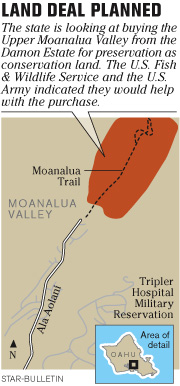State plans to conserve Moanalua land buy
The state is moving forward on a proposed purchase of 3,716 acres in upper Moanalua Valley which would be set aside to conserve the home of rare and endangered Hawaiian birds, snails and plants.
The Board of Land and Natural Resources approved getting a real estate appraisal of the land yesterday, which is being offered by the Samuel M. Damon Estate.
The nonprofit Trust for Public Land has been coordinating a pooling of government resources to buy the conservation land and place it in state ownership.
So far, available funds include $3 million allocated by the state Legislature, $1.6 million from the U.S. Fish and Wildlife Service and the potential of up to $900,000 from the U.S. Army.
"It's really an important watershed area, and there are a number of endangered species there," said David Smith, Oahu wildlife biologist for the state Division of Forestry and Wildlife.
The Oahu elepaio and Oahu iiwi are found there, and the area boasts the last confirmed sightings of the Oahu creeper, another bird, and the last Oahu sighting of the Hawaiian hoary bat.
The land is at the mauka end of Ala Aolani, beginning at Moanalua Valley Park and extending up to the Koolau ridge line. It also is home to 14 federally listed or candidate endangered plants and three kinds of endangered tree snails, Smith said.
The area also has historic bridges, built by the Damon family, and a petroglyph stone called Pohaku Kaluahine, said Joshua Stanbro, Hawaiian Islands project manager for the Trust for Public Land.
"This valley is historic, as anyone who remembers when the H-3 was supposed to go through there," said Tim Johns, chief executive of the Damon Estate. "There are biological, cultural and historical values to the property, and it's a relatively pristine valley relatively close to urban core."
Johns is also a member of the state Board of Land and Natural Resources and recused himself from voting on the appraisal. He did confirm that Damon Estate trustees will consider a state offer.
 The potential sale would not include Moanalua Gardens, a separate 22-acre parcel near the Moanalua Freeway which also is owned by the Damon Estate.
The potential sale would not include Moanalua Gardens, a separate 22-acre parcel near the Moanalua Freeway which also is owned by the Damon Estate.
The estate, which is selling off its assets and dissolving, has not said what will happen to Moanalua Gardens.
If the state gets the upper Moanalua Valley land, it would become part of the Honolulu Forest Reserve, Smith said. The state would manage the area to preserve the native habitat, watershed and native species, and would probably allow hiking and hunting, he said.
"I think the Damon Estate would really like to protect the valley, to leave it behind as a legacy for the family," Smith said.
Stanbro said the proposed purchase would mark the third significant acquisition of conservation land since the state passed the Legacy Lands Act last year, which earmarks a portion of the conveyance tax on high-end real estate for buying conservation land.
The others are the multiplayer deal (among the U.S. Army, state, Office of Hawaiian Affairs, National Audubon Society and City of Honolulu) to purchase Waimea Valley for $14 million, and a cooperative buy of Honuapo on the Big Island, Stanbro said.
In the 225-acre Big Island deal on the Kau Coast, the state will ultimately get $3.4 million worth of land for about a $1 million investment, Stanbro said. Other participants in the deal are the National Oceanic and Atmospheric Administration, Hawaii County and the private group Ka Ohana O Honu'apo.
"I think the momentum is building within the land conservation community, first with Waimea Valley and then with these two," Stanbro said. "There's a lot of potential to do a lot of good work for not much cost to the state," he said.

